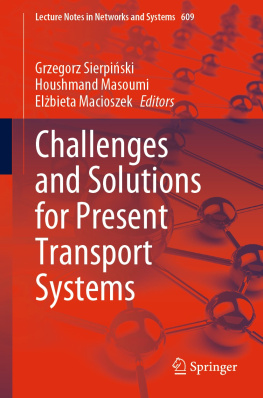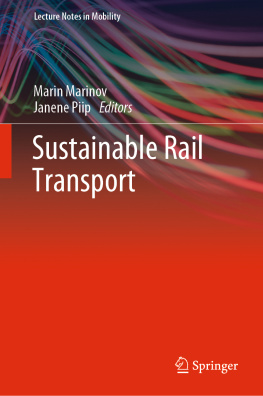Barakaldo Books 2020, all rights reserved. No part of this publication may be reproduced, stored in a retrieval system or transmitted by any means, electrical, mechanical or otherwise without the written permission of the copyright holder.
Publishers Note
Although in most cases we have retained the Authors original spelling and grammar to authentically reproduce the work of the Author and the original intent of such material, some additional notes and clarifications have been added for the modern readers benefit.
We have also made every effort to include all maps and illustrations of the original edition the limitations of formatting do not allow of including larger maps, we will upload as many of these maps as possible.
RAIL TRANSPORT AND THE WINNING OF WARS
BY
GENERAL JAMES A. VAN FLEET, U.S. ARMY (RETIRED)
TABLE OF CONTENTS
Contents
TABLE OF CONTENTS
REQUEST FROM THE PUBLISHER
Introduction
Rail Transport and The Winning of Wars
by
General James A. Van Fleet, U.S. Army (Ret.)
Commanding General, Eighth Army, Korea
14 April 195111 February 1953
This survey reviews the role of railroads in national security. It is based upon both personal observation and recorded experience of the effect of rail transport, or the lack thereof, on the outcome of campaigns and the winning of wars.
I hope the facts presented and the conclusions drawn may be helpful in current military thought and a contribution to the national defense.
19 March 1956
Washington, D.C.
Illustrations
Power for the Big Push: American locomotives stored in Wales for use after D-Day in moving supplies forward to our armies advancing on the continent
A Reconstructed Railway Bridge: American officers ride the locomotive of the first train to cross the Han River, near Seoul, on a bridge rebuilt by American engineer troops
The Railway Bridge Complex at Chongju: Despite the results of the attack upon Communist rail lines shown here, supply lines were quickly restored to service
Wreckage of Communist Supply Trains: Cars, locomotives, track and roadbed all were heavily damaged by bombing but rail supply lines soon recovered from even such damage as this
Passing the Ammunitionby Rail: Narrow-gauge train moving southward from Lingayen carrying ammunition to support the drive for capture of Manila
A Rail Crossing Replaced: 90-foot high earth fill with which American construction troops replaced a damaged 10-arch bridge across the Savone River in Italy
Hauling Supplies by Rail to Russia: Railroad cars loaded with transport and military supplies in the Teheran Yard, in July 1944
Camouflaged Bridge in North Korea: Railroad bridge disguised to appear to have been put out of commission by American bombers. Actually the bridge was sound and usable
The Bridge at Carlsons Canyon: Photograph made one week after bombing attack shows cribbing replacing two damaged spans. The bridge was finally replaced by a bypass around the head of the canyon
Quick Change of Engines: An example of the benefits of standardization of equipment and procedure in the quick replacement of an engine in a diesel locomotive and its prompt return to service
A Critical Logistic Link: The Ludendorff Bridge at Remagen, Germany, capture of which touched off the encircling movement which resulted in capture of the Ruhr district by American troops
Saving Lives: A hospital unit car of the Medical Department, United States Army, used for transportation of wounded and sick soldiers
Bypass or Alternate Lines: Illustration of the use of bypass lines by the Korean Reds
From Rail to Ship: A small bit of one of the facilities for handling tonnage between vessels and cars
Oil by the Trainload: To avert a threatened oil shortage in the East, railroads were called upon to handle as much as 1,000,000 barrels a day during World War II
At Work to Restore Service: Italian military railway forces helping to clean up destruction and restore railway facilities near Rome
Tanks by the Trainload: Whether it be piggyback for a truck trailer, or for a tank, rail transport is basic in the supply lines of the armed forces
LESSONS FROM EXPERIENCE
How could the Chinese Communist Armies in Korea supply themselves in hostile territory 200 miles from their Manchurian base and in the face of the terrific interdiction program of the United States Air Force and Naval Air?
This amazing logistical performance of the enemy raised questions never fully answered at Eighth Army Headquarters. We knew they were getting the bulk of their supplies by rail. We knew the location of all rail lines. We had air and naval supremacy. But in spite of all our air and naval interdiction attacks, their railroads continued to keep them supplied, even to the point of building up reserves for offensive actions! How could they do it?
Enemy Logistics in Korea
The air effort by our pilots was magnificent and did tremendous damage. The armed aerial reconnaissance, the night intruder strikes, the massive Operations STRANGLE and SATURATE, the naval blockade and gunfire by ships offshore, and the sabotage operations by our raiding parties and friendly guerrillasour whole interdiction programcaused vast destruction.
Repeatedly I was assured by my own staff, and by the Air Force and Naval Air, often supported by photographs, that a mile or more of rails at critical points or the bridges at Sinanju or the East Coast Line were out for good. But always, a few days later, locomotives pulling trains were operating at these very locations! In short, we were witnessing, this time to our own military disadvantage and frustration, another demonstration of the capacity, the durability, and the flexibility of railroads under war conditions.
Without ground pressure by Eighth Army, June 1951 to July 1953, the enemy by his standards was having a good timeenjoying ample supplies at the battleline and casting insults at Panmunjom. The Korean war more and more became a matter of logistics. Perhaps had Eighth Army withdrawn voluntarily to the tip of the peninsula, thereby doubling the length of enemy supply routes, and at the same time furnishing additional lucrative targets for our pilots, the Reds might have collapsed. Our air people share that view. My own position is that if all armsGround, Sea and Air had struck together the pressure would have been too much for the enemy. With Eighth Army ordered on the defensive, the air effort could not win by itself.
My Concern With Transport
As a combat commander in World War II, Greece, and Korea, I had to concern myself constantly with transportation matters. When Napoleon made his famous statement that an army travels on its belly, he meant that troops go no farther and no faster than supplies of food, clothing, ammunition, and equipment can be moved. He could have added that a commander can maneuver and put into battle no more troops than his logistical resources can support.











